
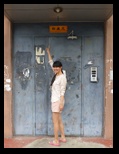
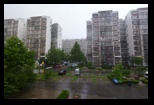
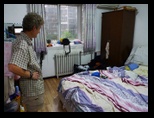

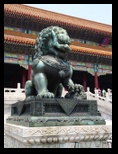
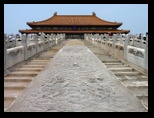
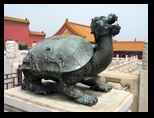

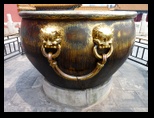
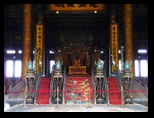


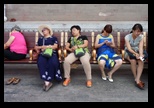
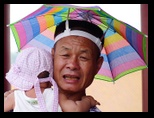
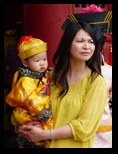
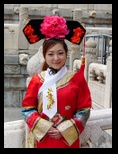
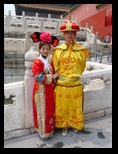
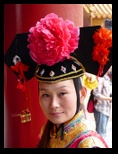
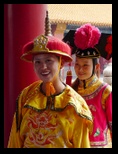
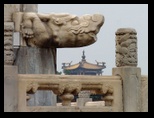
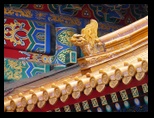
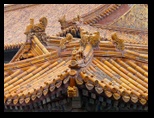
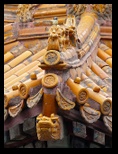
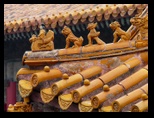

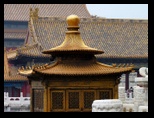
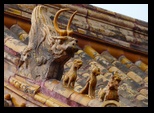

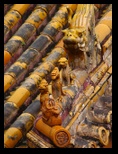
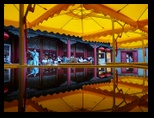
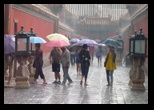
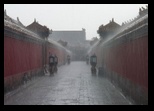
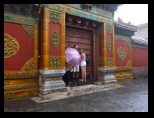
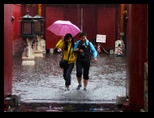
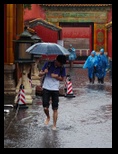
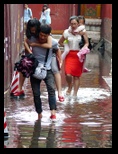






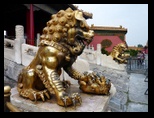
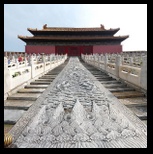
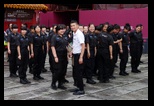
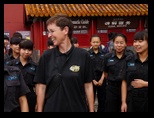
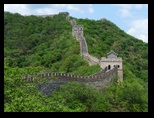

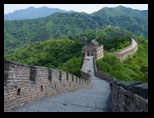
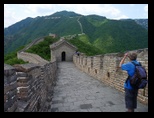
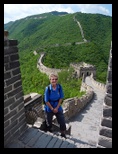
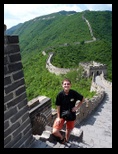
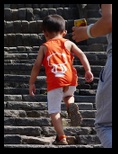

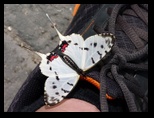

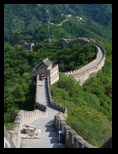

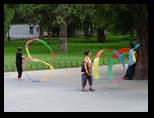
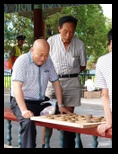
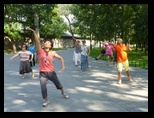
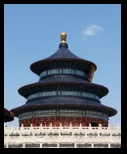
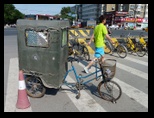
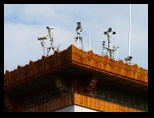
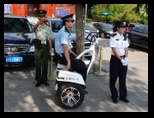
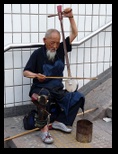 Steintore
Steintore
Click on a photo to enlarge it.
The Forbidden City
The Forbidden City was the Chinese imperial palace from the Ming dynasty to the end of the Qing dynasty. It is located in the centre of Beijing, China. It served as the home of emperors and their households as well as the ceremonial and political centre of Chinese government for almost 500 years.
Built in 1406 to 1420, the complex consists of 980 buildings and covers 72 ha (180 acres). The palace complex exemplifies traditional Chinese palatial architecture, and has influenced cultural and architectural developments in East Asia and elsewhere. The Forbidden City was declared a World Heritage Site in 1987, and is listed by UNESCO as the largest collection of preserved ancient wooden structures in the world.
Construction lasted 14 years and required more than a million workers. Material used include whole logs of precious Phoebe zhennan wood found in the jungles of south-western China, and large blocks of marble from quarries near Beijing.
National Geographic: Inside the Forbidden City, Beijing
Great Wall Of China
The Great Wall of China is a series of fortifications made of stone, brick, tamped earth, wood, and other materials, generally built along an east-to-west line across the historical northern borders of China to protect the Chinese states and empires against the raids and invasions of the various nomadic groups of the Eurasian Steppe. Several walls were being built as early as the 7th century bc; these, later joined together and made bigger and stronger, are now collectively referred to as the Great Wall. The wall built 220-206 BC by Qin Shihuang, the first Emperor of China, is more famous. Little of that wall remains but Since then, the Great Wall has been rebuilt, maintained, and enhanced. The majority of the existing wall is from the Ming Dynasty.
The main Great Wall line stretches from Shanhaiguan in the east, to Lop Lake in the west, along an arc that roughly delineates the southern edge of Inner Mongolia. A comprehensive archaeological survey using advanced technologies has concluded that the Ming walls measure 8,850 km (5,500 mi). This is made up of 6,259 km (3,889 mi) sections of actual wall, 359 km (223 mi) of trenches and 2,232 km (1,387 mi) of natural defensive barriers such as hills and rivers. Another archaeological survey found that the entire wall with all of its branches measure out to be 21,196 km (13,171 mi).

National Geographic: Great Wall Of China
Mon to Fri, 09. - 13.06.2014: Shanghai to Beijing, sunny/cloudy/rain, 28°C - 34°C
We got a taxi to the airport and our flight was delayed. We were put on an earlier flight but that one was also delayed. So we had time to make ourselves a cappuccino before we boarded for the 2 hour and 45 minute flight to Beijing.
We were staying in a guest room with Zimo, her sister and husband. We found it on www.airbnb.com after spending over 5 hours searching for a hotel in our price range on other websites and failing miserably.
Zimo had sent us emails written in both English and Chinese that we could show a taxi driver so that he could phone her for directions from the airport. The taxi drivers don't speak English and this helped us a great deal. Zimo came out to meet us and show us where to go. Her flat was on the first floor of one of many blocks of flats that all looked the same so she pointed out how to spot the right one.
Zimo cooked for us and we had real authentic Chinese food! We had an egg and tomato dish along with dishes of eggplant, bitter gourd (too bitter for us) and garlic stalks plus boiled rice. There is no photo of the meal which shows that Kirsten was getting fed up of taking them! Well it has been a long trip!
We chatted to Zimo and her sister and then had showers - there is only one bathroom which we will be sharing and we also used our own towels for the first time. We have carried them around with us for thousands of miles and are only using them right at the end of our trip!
We only had three days of sightseeing left to do and on the first one we took the metro to Tiananmen Square. There were three train changes and a lot of walking in between with lots of stairs. It took us over an hour to get to the huge square.
Our destination was not the square but the Imperial Palace better known as The Forbidden City. It served as the Palace for 24 Emperors of the Ming and Qing Dynasties and was a maze of 800 buildings with 9,000 chambers. The original building which no longer exists began with Kublai Khan during the Mongol Dynasty and the current buildings are from the 15th Century and have been renovated several times.
The main building was built between 1407 and 1427 with a 50 metre moat around the whole complex which housed the Emperors along with 20,000 Eunuchs and Concubines.
The entrance fee cost $10 each and it is a huge area. We spent 4 hours there and although it was busy, it was a week day so it could have been worse. We gave up on the ebook reader because there were information boards written in English at every building.
A lot of the buildings were blocked off or empty. I took a video of Kirsten trying to get a photo of the Emperor's Throne whilst being pushed and shoved by everyone else who wanted the same shot! The throne was the only item in the building and there was only one place to get a photo - the rest was blocked off, hence everyone was pushing and shoving.
We walked through one courtyard looking at the buildings and then into another courtyard and then another. It is hard to describe just how big the place is. The buildings all looked the same and there were just too many of them. After a couple of hours we were getting bored but then a huge storm came over and our visit became a highlight!
We sat out the hail and pouring rain under a yellow umbrella at the Palace bakery for 25 minutes. But we made the mistake of moving too soon - we got caught in a second bout of pouring rain. We ended up dashing into an open doorway along with lots of other people trying to get shelter.
We were there for 45 minutes then the others left but another downpour came and our doorway no longer gave us the shelter we needed and we got soaked! That's when it got really interesting because the whole complex was flooded. People were wading through at least 4 inches of water. Some went barefoot, others gave piggy backs.
It was quite comical watching people trying to climb around to avoid the water and then doing the same ourselves! We finally got out to non-flooded areas and got great photos of reflections. The storm had definitely cheered us up and Kirsten was a happy bunny again taking photos.
Thunderstorm and chaos in the Forbidden City in Beijing.
We had a very long walk back and then went hunting for a restaurant and food. This took us a long time and eventually we settled for one where the food ended up being terrible - fatty barbecue pork, overcooked and dry rice, vegetables that were cold. We finally found a bakery where we spent $11 on bread and cakes for that night and the following day.
We got the metro back and put out our wet shoes and socks to dry by the window.
Lots of people in the Beijing Metro.
The next day we went to the Great Wall of China. It is the largest man-made monument ever to be built with a total length of over 20,000 km (12,500 miles) and is visible from the moon. The wall is a series of fortifications made of stone, brick, wood, tempered earth and other materials and was built on an east-west line along the northern borders of China to protect against intrusions from various nomadic groups and military incursions.
Several walls were being built as early as the 7th Century BC which is now joined together and is collectively known as the Great Wall of China. The majority of the existing wall was built in the Ming Dynasty - 1368 to 1644.
We were going to the Mutianyu section of restored wall which is quieter than the main tourists parts so that we could avoid the crush of people. It was also a Wednesday which meant we would avoid the weekend hoards.
Once again we had a problem getting there and had to fend off people trying to rip us off. We had downloaded various things written by Zimo in Chinese and English on our e book reader to help us mainly with our return journey and didn't think we would have too much of a problem getting to one of the most famous tourist destinations in the world. Hmmm! It didn't quite work out that way!
All we had to do was to walk to the nearby Metro station, cross the road and get on the correct bus for a one hour journey. That was the easy part. But after 50 minutes, a man who we thought was the bus driver, told us to get off. Only when the bus left did we realise that we had been pulled off the bus early by a taxi driver who wanted to charge us extra to get to the Great Wall!!
We knew we'd been had, so after wasting 30 minutes and getting truly pissed off, we got onto another bus 916 to go another 4 stops and get off where we were supposed to. Fortunately, the bus driver didn't try to charge us again - they are obviously aware of this "tourist trap"!
Once at the correct stop we were virtually assaulted by a taxi driver who got so close to Kirsten's face I thought he was going to kiss her!! We finally negotiated a price for the 25 minute taxi ride. We already knew roughly how much this would be and how long it would take, knowing that someone would probably try to take advantage and over charge.
The taxi driver wanted to wait for us and then was surprised when we said we would walk up to the wall rather than take the cable car. He tried to tell us there wasn't enough time. Well, admittedly it had taken us longer to get here than we thought and it was already noon, but we sent him on his way.
We bought our $6 entrance tickets and climbed hundreds of steps up the 300m ascent (930ft) and spent 5 hours on the wall. (The cable car would have cost $13 return or $10 one way).
The problems getting there were well worth the effort and we had a wonderful time. It was exhausting though because the wall follows the contours of the hills with hundreds more steps up and down and some very steep stretches, particularly up to the many towers.
We went from tower 10 to 20, then returned and went the other way to tower 1 where the restored part of the wall finishes and further exploration is blocked off.
At times we had the wall to ourselves which was a real bonus and we had great views. We could even see parts of Beijing 70 km away (45 miles).
Walking on the Chinese Great Wall (Mutianyu stretch).
We really enjoyed our time there and it was definitely one of the many highlights of this trip. We walked back down and got a taxi to the bus station and back home. It was a good job we had our ebook reader with the Chinese for getting to the bus station and getting on the correct bus back - we certainly needed it.
We bought some "chobing" which are like Chinese pasties and some savoury pancake style food to take back and share with Zimo, her husband and sister along with rice and various dishes that Zimo had prepared. We enjoyed telling them all about our day and showed them photos and videos from our trip.
For our final day in China we took the Metro and went to the Temple of Heaven - built in 1420 as a place for fasting and prayer. It is a large area with various buildings and gardens. It was very hot and we wandered around the grounds watching the various activities taking place. A lot of people come here for aerobics, card games, discussions and we even tried a game which I dubbed "kicker shuttlecock" because we couldn't understand (or pronounce) the Chinese name for it.
Sport and game activities in Beijing
We also went to Tiananmen Square which is huge but it was all blocked off with large barriers and we were only allowed to walk along one side. Oh well, we can't have everything and that was our last sightseeing for this whole trip ... Hurrah!!!
The following day we didn't need to leave for the airport until 10-30pm so we spent the day packing, writing the diary, sorting out various things and even managed to watch a replay of the opening World Cup match between Brazil and Croatia.
Our 7 month backpacking tour had finally come to an end. We have seen a huge amount starting with a luxury week in Dubai then battling through the dirt and filth of India where we got very sick and the highlights were the tigers and a wonderful week on the beach in Goa, followed by a superb time in Myanmar and the pristine majesty of trekking in the Himalayas, a tour in Tibet and the highest train ride into China, the Terracotta Army, Shanghai and Beijing. Phew!! Exhausting!
Now it's time to visit family in Hamburg and England and to see if we've tipped the right scores in the World Cup!